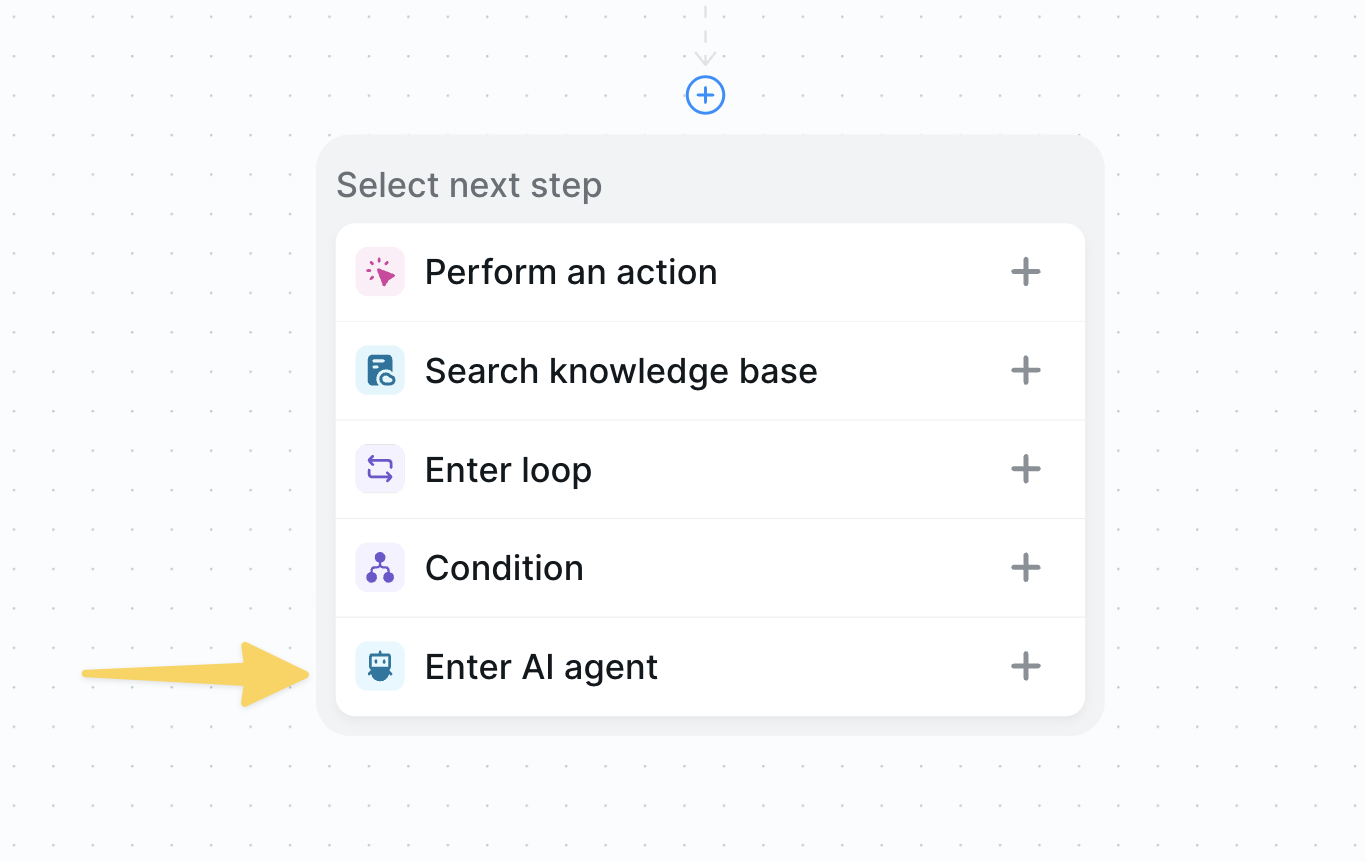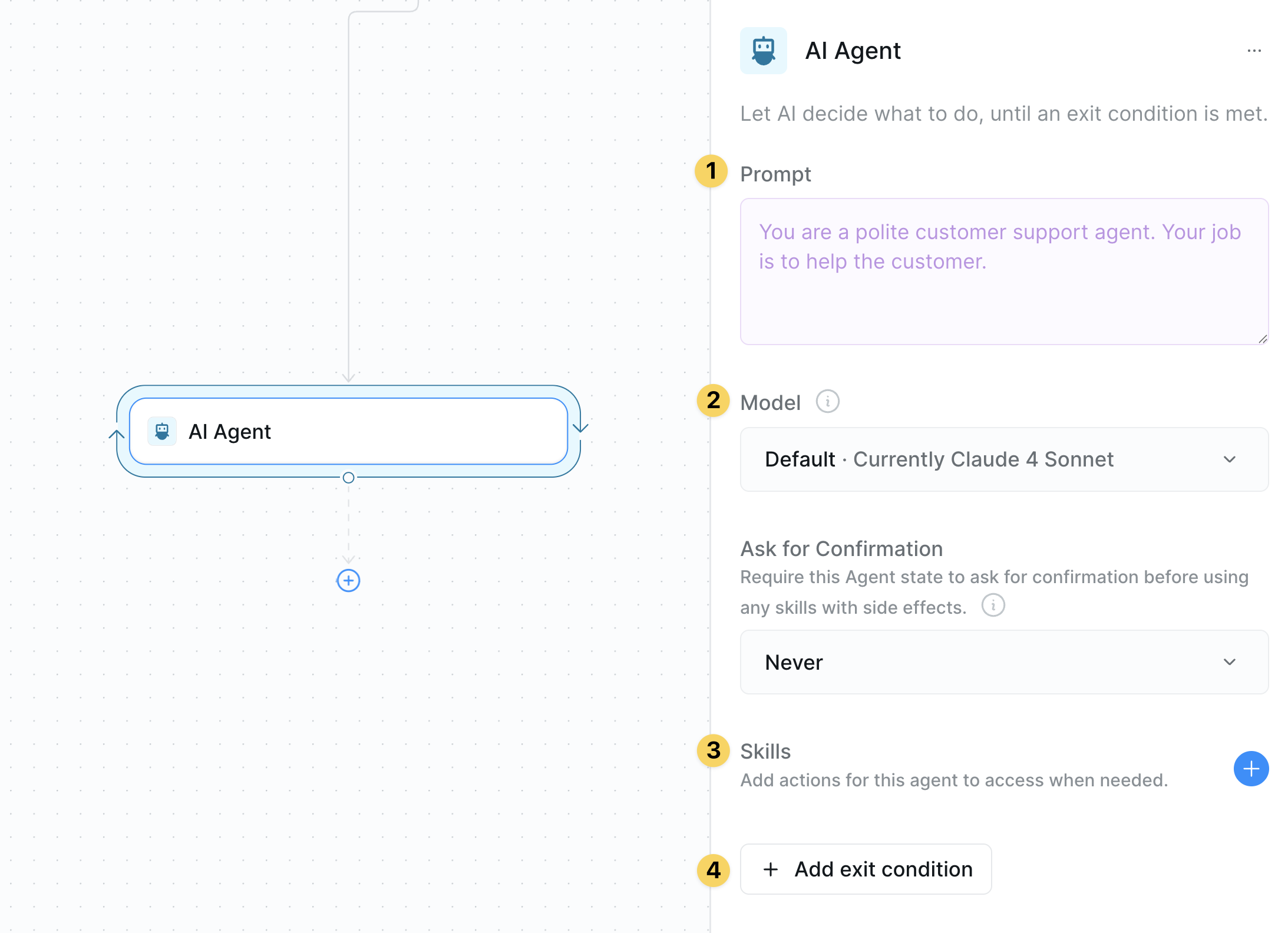Quick Overview
Agent steps let your AI make autonomous decisions about how to complete complex tasks. Instead of following fixed workflows, they work from guidelines you provide and choose which skills to use based on the situation. Think of them as hiring a smart assistant who can adapt to unexpected scenarios. They’ll keep working until they meet your exit conditions, using whatever combination of skills they need to get the job done. Agent steps are powerful but more expensive than standard actions. Use them only when the next steps are genuinely uncertain and you need intelligent decision-making.Understanding AI Agent Components
AI Agents consist of four essential parts that work together:- Prompt: The core instructions that guide your agent’s behavior. Think of this as the agent’s mission statement - what it should accomplish and how.
- Model: The AI model (e.g., GPT-4, Claude) that powers the agent’s decision-making capabilities.
- Skills: The actions and capabilities available to the agent. These are the tools it can use to accomplish its goals.
- Exit Conditions: Criteria that tell the agent when its task is complete and it should proceed to the next workflow step.
Adding an AI Agent

Configuring Your AI Agent
Setting the Agent Prompt

- Role definition: Who is the agent and what’s their expertise?
- Clear objectives: What specific outcomes do you need?
- Process guidance: How should they approach the task?
- Quality standards: What level of accuracy and detail is expected?
- Exit conditions: When is the task complete?
Adding Skills
Skills are the tools and actions your agent can use to accomplish its goals. Think of them as giving your agent specific capabilities — like the ability to search the web, send emails, or analyze data.
How skills work:
- Your agent can use skills multiple times and in different combinations
- Skills can be used in sequence (search, then crawl results) or iteratively (search → analyze → search more if needed)
- The agent will explain its reasoning for using specific skills
- Web Search: Finds relevant web pages, articles, and resources across the internet. Your agent will craft search queries, evaluate results, and follow promising leads.
- Website Content Crawler: Extracts and analyzes content from web pages. Once the agent finds relevant sites through search, it can crawl them to gather detailed information about companies, verify facts, and extract structured data.
- Start with 2-4 essential skills rather than overloading with options
- Consider how skills complement each other in your workflow
Defining Exit Conditions
Exit conditions tell your agent when its work is complete and it should move to the next step in your workflow. Think of them as success criteria that define “done” for your agent’s task.
How exit conditions work:
- Your agent will keep working until at least one exit condition is satisfied
- You can have multiple exit conditions — the agent stops when ANY of them is met
- Exit conditions should be specific and measurable
- The agent evaluates conditions after each action it takes
-
Primary success condition:
-
Fallback condition:
-
Time/effort limit:
- Include a fallback option for when perfect results aren’t achievable
- Be specific about what constitutes “completion”
- Consider both ideal outcomes and acceptable partial results
- Use measurable criteria when possible (e.g., “found at least 80% of required data”)
Best Practices
Use Agent Steps Only When Necessary
Use Agent Steps Only When Necessary
Only use agent steps when the next actions are genuinely uncertain. For predictable workflows, use standard actions and conditions for better reliability and lower costs.
Write Comprehensive Prompts
Write Comprehensive Prompts
Include all five key elements: role definition, clear objectives, process guidance, quality standards, and exit conditions. Structure your prompt with clear sections like the research agent example.
Choose Complementary Skills
Choose Complementary Skills
Start with 2-4 essential skills that work well together. For research tasks, pair search with content extraction. Avoid overloading with too many options.
Include Multiple Exit Conditions
Include Multiple Exit Conditions
Always provide a primary success condition and a fallback option. Be specific about what constitutes completion and use measurable criteria when possible.
Test with Diverse Scenarios
Test with Diverse Scenarios
Agent steps introduce variability. Test with different inputs to ensure consistent performance and adjust prompts based on results.